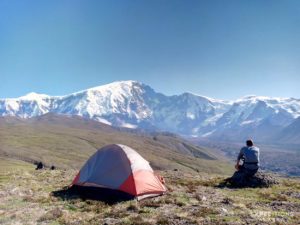Hey Folks
I get asked all the time which kind insulation fill is best for a sleeping bag for someone planing an Alaska backpacking trip. Like almost all these kinds of questions (such as what size backpack you need), the answer is pretty subjective, and I really don’t think it matters too much. What matters is that you make the decision that best fits your particular set of circumstances. That said, here are a few notes that may help you in your decision-making. I own both down and synthetic bags, and I honestly don’t find the type of fill to be the deciding factor in how I like a bag.
- Down:
* lightweight for warmth – Even the best synthetic fill can’t match down for it’s weight/warmth ratio.
* compressable – Down bags will compress down into a smaller size package than any equivalent synthetic bag.
* longer life – Down doesn’t break down like a synthetic material does, and so will generally, with reasonable care, last longer.
* comfort – Most people say down ‘feels’ better. I think it’s because t’s generally lighter, but I must admit, I do like down bags.
- Synthetic:
* cheaper – a 20deg synthetic bag will be substantially cheaper than a 20 deg down bag.
* insulates when wet – synthetic fill reputedly don’t lose any, or very much, of their insulating properties when they get wet.
* dries faster – Down bags take a longer time to dry, and synthetic bags tend to dry reasonably quickly.
- Down:
* loses insulation properties when wet.
* dries slowly (I’ve had a bag get wet, and was impressed with how quickly it dried (overnight) – but definitely slower than a synthetic fill bag would.
* expensive.
- Synthetic:
* heavier.
* less compressable.
* less durable. Synthetic filaments will break down over time, sooner than down bags typically do.
However, I have to point out that each of these is relative. A synthetic bag, soaked in cold glacial river, is less warm than a lighter weight but dry synthetic bag. And if your bag is wet, and the temperature drops to 32deg, don’t expect to be too toasty in it. It depends, of course, on many things, but how wet the bag gets is one of them. I’ve had a down bag get soaking wet, and I was actually surprised how warm I stayed, and how quickly it dried out – overnight. Further, in years and years of spending countless nights in the backcountry and camping in general, I’ve only had a sleeping bag get wet twice. For most people, this really isn’t, IMO, much of an issue.
How important each of these factors are will depend on a lot of subjectivity. I like a down bag that weighs less, and compresses down to almost nothing, because I typically carry a fairly heavy pack, weighed down with heavy bulky camera gear. The more weight and space I can save elsewhere, the better. Your mileage may vary. I really don’t think it matters if you have a synthetic bag or a down bag. With reasonable care, you should be able to get years of use out of either type bag and your bag should almost never get wet in the backcountry.
One thing I will add that even with down fill, not all down is the same. 600 power fill down is not the same thing as 850 or 900 power fill. Generally, the higher that number, the better the down quality is: it’s warmth/weight ratio is better, it last longer, breaks down less, and is more compressable. Synthetic filaments are similarly not all equal, so the question of down versus synthetic is somewhat incomplete.
Lastly, if you go for a down bag, it’s hard to beat Western Mountaineering and Feathered Friends they specialize in down, and I don’t know of anyone who makes a better product. Marmot would be close behind though, as are Montbell. Mountain Hardwear make some nice stuff, but I think they should put a full length zipper in their lightweight bags. I also think they overrate the temperatures of their bags a bit .. but so do most companies. The North Face make great bags.
For synthetic fill bags, Sierra Designs make a few nice bags, and the REI brand bags can be a very cost effective choice. They’re not too bad at all, and more affordable than most, though their temperature ratings are also, IMO, suspect.
Either way, hang your bag or stuff it in a cotton sack, not compressed, when it’s not in use. I handwash my down bags, and try to take good care of them. My North Face Foxfire is still a great bag, and it’s 13 years old. I’d also suggest not over-compressing even down bags when you go hiking. The compression sacks you can buy are great, but i’m not sure it’s in the best interest of your bag to compress it too much – even down can only handle so much.
Here’s some great advice for looking after a down bag:
Western Mountaineering Webpage.
I hope this helps. The main thing is to not stress too much over it, and know that most bags are going to be just fine for most people. Buy one, or use your old one, and enjoy the backcountry!
Cheers
Carl




